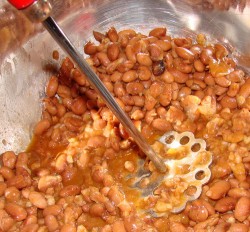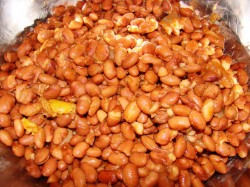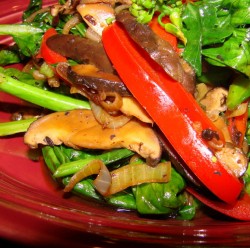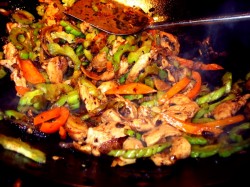Wholly Vegetarian Refried Beans (Which Taste Like They’ve Been Cooked With Pork)
I grew up eating lots and lots of dried beans, simmered on low heat all day, in a big pot, seasoned with a ham hock. My favorites were pinto beans, which were usually served in a bowl with diced raw onions on top and cornbread on the side. They may or may not have had any other seasonings, such as a bay leaf, some garlic or hot peppers, but the one thing pinto beans always had in them was salt, pepper and either smoked jowl bacon, fatback or a ham hock.
Ham hocks gives an absolutely divine richness to the broth, and flavors the beans with the sensual kiss of the smokehouse.
Over the years, I have eaten many sorts of vegetarian beans, and while they may be quite good, most of the time they are missing that smoky richness that just says, “beans” to my palate.
So, most of the time, when I am making soup beans or beans for refried beans (refritos), I haul out whatever bit of smoked hog I have on hand, and toss it in the pot with the beans and start simmering.
However, when one is cooking for one’s Muslim friend and one’s eight month old baby, neither of whom are going to be eating pork any time soon, one has to change one’s ways.
And that is fine. Pork fat may be good for the soul, (and the beans) but it is less good for the figure.
But, how to get that signature smokiness that I want in my beans?
Well, one could use smoked turkey wings, which I have done to great effect in making lower fat beans and greens in the past. However, Kat is still not eating meat under doctor’s orders, so smoked poultry is right out of the equation.
Under normal circumstances, meaning, if I was cooking only for adults, I would use chopped up chipotle chiles to provide the smoky flavor, but since Kat is fond of spices, but not so much heat, I cannot go that route, either.
What to do, what to do?
I suppose I could resign myself to eating beans sans smoke, but I don’t want to do that, and neither does my palate. My tastebuds are quite stubborn and once they have it in their minds that beans taste smoky they don’t want to let go of that concept, and will thus start triggering cravings for smoky goodness that can only be satiated with fifteen pounds of bacon or a whole ham or somesuch evil nonsense, unless I give in and just give them what they really want, which is some nice, creamy, smoky refried beans that smell of all the goodness of smoked pork products.
In my pantry, I realized I had the secret to rich, smoky fully vegetarian pinto beans and thus, refried beans: Spanish Smoked Paprika.
Also known as Pimenton de la Vera Dulce, Smoked Spanish Paprika is a bright russet red colored spice derived from ripe sweet peppers that have been smoke dried slowly over an oak fire for weeks, then ground into a powder. (It also comes in a hot version called Pimenton de la Vera Picante, which is similar to Chipotle chiles, but not as hot.)
It is great stuff, fragrant and full of flavor and color, and I found that by adding a tablespoon and a half to the vegetable broth while cooking the beans produced gave them an amazing smoky punch and colored the broth a rich reddish brown.
Once the beans were mashed, salted and ready to be fried, I found that they were just as good as ones cooked with a ham hock, but were lower in fat and calories, as well as being perfectly baby safe and Muslim-approved.
Woohoo!
For Kat, I pureed the beans completely, but for the rest of us had them fairly chunky. (I like to leave plenty of texture in my refrieds.) I also added some chipotle to our chunky beans after I took out Kat’s and pureed them, so we older folks could have a bit of zing in our beans.
Wholly Vegetarian Smoky Refried Beans
Ingredients:
1 pound dried pinto beans, picked over, rinsed and soaked in water overnight
1 1/2 quarts vegetable stock or broth
1 small onion, diced roughly
5 large cloves garlic, peeled and crushed
1 bay leaf
1 1/2 tablespoons Spanish Smoked Paprika (sweet)
3 tablespoons olive oil
1 large onion, finely diced
1 teaspoon salt
6 cloves garlic, peeled and minced
1/2 teaspoon ground cumin
1/4-1/2 teaspoon ground dried chipotle chile
salt to taste
1/2 cup loosely packed coriander leaves, roughly chopped
Method:
Drain pinto beans and rinse again. Put into a pot with stock or broth, onion, garlic, bay leaf and paprika, bring to a boil, and turn down heat so it simmers. Simmer until beans are tender and are just falling apart.
Scoop beans out of the broth with a skimmer or drain the liquid, reserving the juice, in case you need it to moisten the beans after they are mashed.
Using a potato or bean masher, as pictured above, (or a stick blender) mash the drained beans to the texture you prefer. (Do not remove the onions and garlic that were cooked in the beans–mash them up, too.)
After the beans are mashed, heat olive oil in a heavy bottomed pan big enough to hold all the beans. Add onions and sprinkle with the teaspoon of salt. Cook, stirring, until the onions are a dark golden/light brown color. Add garlic and keep cooking until the garlic is fragrant. Sprinkle cumin and if you are using it, chipotle chile into the pan, then add the beans all at once.
Stir to thoroughly mix beans with oil and aromatics. Keep cooking, stirring continually, until the beans dry out somewhat and become creamy and thick. Salt to taste, then right before serving stir in cilantro.
What can you do with refried beans, other than feed them to your baby? (Kat likes them as much as she likes guacamole, curry and carrot potato soup.)
They are a great filling for burritos, I like them in my Mexican rice casserole, Arroz Gratinado, and they are a classic side dish with rice.
They are also great in nachos! Just layer good quality tortilla chips in a baking sheet, dot with hot refrieds, sprinkle with grated cheese, top with scallions, cilantro and jalapenos and run under the broiler until the cheese is melted and bubbly. Then, serve with guacamole and the salsas of your choice for a great snack.
Morganna’s Simple Vegetable Stir Fry Using Barbara’s Rules of Three
To test my theories on making simple Chinese stir fries, Morganna set out to follow my Rules of Three, and concoct a vegetarian dish to accompany another stir fry I was making that included meat.
Morganna is generally no better at following formulas and recipes than I am, but she stuck to the premise of my posts, and came up with a very simple recipe that she thought was tasty, nourishing and aesthetically pleasing.
In my posts, I have suggested using only three main ingredients: a protein or mushroom, a green vegetable (preferably leafy) and an orange, yellow, red or white vegetable. For her main ingredients, Morganna chose fresh shiitake mushrooms, (substituting for a protein ingredient, since we were having a separate meat dish), gai lan for the greens, and sweet red bell pepper for the second vegetable. She felt that the soft, yielding texture of the mushrooms would be beautifully set off by the crisp gai lan stems and the barely stir fried bell pepper slices, while the velvety, wilted leaves of the greens would give a different layer of texture. If we had not had gai lan in the fridge, she probably would have used broccoli, as we all love it dearly, especially stir fried.
Out of the list of aromatics, she chose onions for their sweetness, garlic because she loves it, and fermented black beans, because she felt that the savory, slightly bitter umami flavor would be excellent with gai lan and would enhance the earthy meatiness of the mushrooms. She also knew that garlic and black beans are a classic flavor combination which have been used to in various Cantonese dishes for centuries, so she knew that they would work well together. She cut the onion into thin slices so it would brown quickly, flavoring the oil intensely, and she minced the garlic to affect maximum flavor release, while the black beans, she simply mashed roughly.
For condiments, she chose dark soy sauce for its umami boosting flavor and coloring potential, oyster sauce, because it goes so well with gai lan, and sesame oil, because it is one of our family’s favorite flavors and aromas, especially when it is enhancing mushrooms. (Well, actually, Zak like sesame oil on anything but mushrooms, which he dislikes intensely.)
Finally, the supporting ingredients she chose were canola oil as a cooking medium, homemade chicken stock to deglaze the wok and form the backbone of the reduced sauce, and a tiny pinch of sugar which not only would enhance the flavor, but would, when the stock was reduced, act to thicken the sauce very slightly, since she chose to not use cornstarch. The reason she chose not to use the cornstarch was because she wasn’t marinating anything, so the cornstarch wasn’t completely necessary. She also didn’t want a very thick sauce, but instead wanted the sauce to just barely cling to the ingredients as a thin, clear brown glaze.
How did it all turn out?
Well, I was careful not to tell her how to cook the stir fry, and the only advice I gave was the continued admonition to only use three, ONLY THREE, ingredients from each category as she formulated the recipe. She had fun trying to limit herself to the parameters of the Rules of Three, and generally followed the methods I have taught her on how to stir fry, which she has now memorized to the point it is second nature.
The stir fry was excellent, and its earthy, sweet and bitter flavors were a perfect foil for the spicy-sweet braised pork dish I made. The scarlet of the peppers and the vibrant emerald greens brought a sizzle of color to the deep brown mushrooms and black bean-flecked sauce. The mushrooms soaked up the soy sauce, and their meaty flavor was enhanced, while the sweet peppers popped with sugary sweetness. It was an altogether delectable dish, and Morganna was quite pleased with it, as well she should have been.
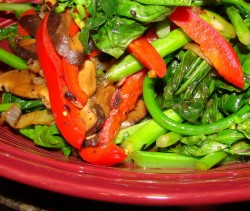
Morganna’s Simple Vegetable Stir Fry
Ingredients:
3 tablespoons canola oil
1 medium onion, thinly sliced
1 tablespoon fermented black beans, lightly crushed
10 large fresh shiitake mushrooms, stems removed, caps cut into 1/4″ thick slices
3 garlic cloves, peeled and finely minced
2 tablespoons dark soy sauce
1 teaspoon raw or brown sugar
1/2 pound gai lan, thick stems removed and discarded, the rest cut into 2″ pieces
1/4 cup chicken or vegetable stock or broth
1 sweet red bell pepper, cored, seeded and cut into 1/4″ thick strips
2 tablespoons oyster sauce
1/4 teaspoon sesame oil
Method:
Heat wok until it smokes, then add canola oil, and allow to heat thirty seconds more, until the oil shimmers with movement.
Add the onion and stir fry about a minute, until it begins to take on color. Add the black beans,a nd stir fry for another thirty seconds or so.
Add the mushrooms, and continue stir frying. When the mushrooms shrink, after about a minute, add the garlic, soy sauce and sugar and stir fry for about another thirty seconds. Add the gai lan and the broth or stock, and bring mushrooms up to the top of the gai lan, scooping the greens close to the bottom of the wok. When the leaves to the gai lan brighten in color and wilt, add the bell pepper and stir fry for another thirty seconds.
Add the oyster sauce and stir fry to combine thoroughly and to heat it through. Remove from heat and drizzle with sesame oil, giving the dish a final stir before scooping it onto a heated platter and serving with steamed rice.
This is the final post on my series of how to create your own simple Chinese stir fried dishes. If anyone uses these ideas to make their own stir fries, and you are interested in me featuring it here, send me a link to it on your blog (or, if you have no blog, send me photos and your description) and I will post a link here in a future post, or will write a post featuring your recipes.
Happy cooking, folks!
Creating Your Own Foolproof Chinese Stir Fry Step Four: The Supporting Ingredients
We are in the home stretch now. This is the final trio of ingredients necessary to make a simple Chinese stir fry, and they are really basic.
They are so basic that when you eat the your stir fried dish, you likely will not even think about them being there. But, they are there, just like they are there in the photograph of a chicken, bitter melon and sweet bell pepper stir fry above.
Without these supporting ingredients, your stir fry will lack in texture, flavor and body.
I like to think of these ingredients as the crew on a stage production. (I mean, we already have the cook as a director, the main ingredients as the stars of the show, the aromatics as the character actors, and the condiments as the supporting stars, so why not carry the metaphor to the end?)
The audience never sees the crew, well, usually not anyway. But without them, the magical suspension of disbelief would never happen. Think about a play where there was no costume mistress, no lighting designer, no stage manager, no properties manager and no stagehands. It would be chaos!
Well, the supporting ingredients in a good stir fry are like that–they keep chaos at bay. The folks eating your dishes may never know that they are in your food–all they will know is that it is good. And that is enough, and that is fine, because if you misused one of these ingredients to the point that its presence was obvious–well, your food wouldn’t taste or feel so good. Trust me on this one. I know–I have made a few “overuse mistakes” in the past.
The first and most important supporting ingredient is cooking oil.
Well, duh, I bet you are thinking. Of course it is important, but do we have to talk about it?
Well, yes, we do.
Traditionally, much of Chinese food was cooked in lard, because it was plentiful, cheap and delicious. When properly rendered and filtered, lard has a fairly high smoking point, in addition to an absolutely delectable flavor. But, among Buddhists who were strict vegetarians, it was not used, so vegetable oils have always been available for use in Chinese foods.
What sort of oils do I suggest people use? Ones with high smoking points are necessary. If you follow my general stir fry instructions, you know that I want your wok to be very hot. That means you need an oil that can withstand high temperatures without either scorching, smoking or catching on fire. Any of these unauthorized kitchen activities can not only ruin a batch of stir fry, it can put a damper on your whole day, so take my advice and use either peanut or canola oil. (Or, heck, if you can get it, unhydrogenated lard. You know you want to–it sure does taste good!)
I prefer peanut oil for several reasons. It is very healthy for you, being a monounsaturated oil, it has the requisite high smoking point and if you get cold pressed peanut oil, it adds an amazing flavor to any food cooked in it.
That said, I understand that there are lots of folks in the world who are deathly allergic to peanuts, so let it be known that I think that canola oil, also a monounsaturated fat, is also a perfectly good cooking medium to slosh into your wok. It has a more neutral flavor which folks who don’t care for peanuts will prefer, and it is less expensive than peanut oil. (For that reason, when I deep fry and flavor is not an issue, I will use canola rather than peanut oil.)
You can use soybean oil or corn oil–I just don’t like the way they taste in the wok There is something heavy and greasy about them and I just don’t care for them as much.
Lard, on the other hand, if I am not cooking vegetarian food or for strict Jews or Muslims, imparts an amazing flavor both to the wok and the food
Cornstarch is the second of the essential trio of supporting ingredients you don’t want to do without in your stir fries. It provides not only a structural element in that it helps thicken the sauce to a smooth glossy finish, but it also helps tenderize meat, and adds flavor when meat coated with it browns in a hot wok.
I almost always use cornstarch as an ingredient in marinades for meat and tofu for several reasons. One, it helps the liquid marinade ingredients stick to the meat or tofu. Two, a coating made of it and a liquid both insulates the outside of a piece of meat from the heat of the wok to a small extent, leading to a more tender cooked product, and it helps meats and tofu brown in the wok. Three, it is a thickener that makes a very clear, glossy, shiny sauce in a stir fried dish.
If you are allergic to corn, you can use arrowroot starch instead. I will warn you, however, that it is a stronger starch that does not require you to use as much of it as cornstarch. As I recall, you use 1/3 as much arrowroot as you would cornstarch. It is also more expensive, so be aware of that as well.
Cornstarch is not used in every Chinese stir fried dish–but it is used in a great many of them, and it pays to learn to use it properly and well. Go easy on it at first; use as little as you need to get the job done. Please-there is nothing nastier than gloppy, mucous-like sauce. (Trust me on this one–there was a very famous time I had made chicken with snowpeas for Zak, long ago, and I used too much arrowroot starch. When I scooped it out of the wok, the clear sauce did not drizzle, it oozed languidly, and glistened like, well, there is no other word for it–snot. It was horrid. I started to cry, and I put it down in front of Zak with the now infamous quote: “Here’s your mucous, Egon.” People still tease me about Egon chicken to this day, though I have never, ever repeated that mistake again.)
Finally, you need to have chicken or vegetable stock or broth on hand to use in your stir fries. It is invaluable for deglazing the wok after the cornstarch marinade has browned on it, and it evens out sauces perfectly. Water is too flavorless, and soy sauce is too salty and wine is too winey, but stock or broth is just right. It thins the sauce to the correct consistency, it adds a subtle bit of meat or vegetable flavor and it does wonders when cooking leafy greens, as a little bit of it poured into the wok near the end of cooking will make just enough steam to cause the leaves to wilt perfectly.
I freeze my homemade stocks in ice cube trays, then pop the little squares into plastic bags. One or two of those little frozen nuggets will be enough for a stir fry. Another product that I have used with good results are the one cup sized chicken or vegetable broths by Pacific Organics. They come in four packs, and I have found that the leftover opened bits will last for a week in the fridge.
Or, of course, you can always pour the leftover bits into ice cube trays and freeze them to be used later.
So, that is it. Those are my Rules of Three.
The only thing your stir fry needs now is a bowl of steamed rice.
And, maybe a garnish of thinly sliced scallion tops, a sprinkling of peanuts or sesame seeds, or some cilantro leaves.
But, the garnish is not necessary–it is just a nice touch.
I hope that this series has been a help in demystifying stir frying and Chinese cookery. I want to inspire cooks to be brave, fire up the wok and make something good tonight, even if you didn’t plan to.
With a handful of ingredients and some creativity, anyone can stir up a feast from their wok.
Good night, and good cooking!
Creating Your Own Foolproof Chinese Stir-Fry–Step Three: The Condiments
What exactly is a condiment?
In the context of this series of posts on creating your own simple Chinese stir fried dishes, a condiment is a bottled or jarred liquid or paste that is used in fairly small amounts to enhance the natural flavors of the main ingredients of the dish without overpowering them.
If your main ingredients are the stars of the show, and the aromatics are the character actors who add pizazz and oomph to the production, condiments are the hard working supporting cast who help the stars shine without making themselves the center of attention. The aromatics, like character actors, often need to be reigned in to keep them from completely upstaging the stars, but condiments are not so pushy. Their main purpose is to add flavor to food without drawing too much attention to themselves in the process.
I wrote a post about the basic staples of the Chinese pantry a while back, and it is a great introduction to the most commonly used condiments in the Chinese kitchen. I also wrote separate posts about soy sauces, soybean pastes and ground bean sauce, which will be helpful for those wanting to get more specific information on these particular condiments.
What I am more interested in talking about in this post is how to combine three different condiments into a cohesive, flavorful sauce for a simple stir fried dish which consists of a protein ingredient, a green vegetable and another vegetable.
In addition to the sauces listed in the basic Chinese pantry post (light soy sauce, dark soy sauce, rice wine or dry sherry, rice vinegar, oyster sauce, hoisin sauce, ground bean sauce, toasted sesame oil, and chile garlic sauce) there are two more ingredients that I will consider as condiments in the context of this series: sugar (white or raw) or honey, and citrus juice, such as lemon or orange.
By combining three ingredients from this list in careful proportions, it is possible to make a nearly endless array of flavored sauces for simple stir fries. Classic combinations abound, and it is useful to know about them, and experiment with them, but do not feel constrained by them.
Probably the most versatile trio of condiments for stir frying is the combination of soy sauce (light or dark) with rice wine or sherry and sesame oil. This mixture, with rice wine making up the bulk of the volume and providing sweetness, soy sauce bringing in the salt component and adding savory umami goodness, and sesame oil adding a nutty smokiness, tastes good with anything. Using light soy sauce in the mixture will give chicken, fish, tofu or pork a delicate flavor that enhances the natural tastes inherent to the main ingredients. Made with dark soy sauce, beef, bison, pressed tofu and shiitake mushrooms will sing.
The ratio I tend to use in mixing the wine with the soy sauce (which I will use both as a marinade and a cooking sauce) is 3 or 4:1, with the wine being the greater value. Toasted sesame oil, because it is strongly flavored and has a low smoking point, is always used in very small amounts at the end.
Another combination which is potent and flavorful is the mixture of dark soy sauce, rice vinegar and hoisin sauce, with the ratio being somewhere along the lines of 1:1:1/2-1. (The hoisin sauce amount depends on your personal taste. I go easy with it, because I think it can overpower a dish, but some people love it and would use it more along the lines of 1:1:1.) These three condiments together make a musky sweet and sour sauce that is a far cry from the sugary, florescent pink concoctions familiar from the menus of typical Chinese-American take-out joints.
If I were making a marinade for a dish using this classic trio of flavors, I would not use the vinegar in the marinade, but would either use soy sauce alone or use soy sauce and hoisin sauce. The reason is that vinegar boils at a lower temperature than water; if you add it early in the stir frying process, it will cook away and you will not taste it. It should be added close to the last minute for the best flavor effect.
A simple combination for stir fried beef and greens is the mixture of soy sauce, sugar or honey and oyster sauce. The ratio for this mixture is 1:1/4:1-2. The amount of oyster sauce used is variable depending on how much you like the flavor. I tend to use about twice as much oyster sauce as soy sauce when I cook with it, but then, I love the savory oceanic flavor it gives, particularly in beef with gai lan or kale. It is quite simply wonderful, particularly if you get a premium oyster sauce. All of these ingredients are safely used in marinades. The addition of sugar to any marinade will help the meat or tofu brown when it hits the hot wok.
A mixture that is delicious with both tofu and chicken is ground bean sauce, rice wine and sugar. The ratio is 1:2:1/8–the sugar is used primarily to balance the salt in the ground bean sauce, not to give a flavor of its own. All three ingredients can be used in a marinade.
Now, when it comes to making a marinade or making a separate sauce to be added at the end, I tend to be the sort of person who either uses all of the sauce ingredients in the marinade, or I split them up and use part in the marinade, and part to deglaze the wok during cooking. I don’t tend to make a sauce at the end. If you review my Stir Fry Technique: Ten Steps to Better Wok Cookery post, you will see my reasoning for making sauces as I go instead of at the end. In short, it is because you end up with a tastier sauce and a more integrated, flavorful dish than you would if you mixed up a sauce and added it at the end of stir frying.
So, how much marinade do I suggest you mix up, and how much liquid (usually wine) do I suggest you keep back for deglazing? Well, for most purposes you don’t need much more than about three tablespoons of marinade for about a pound or a pound and a half of protein. Really, you don’t need much. Once it is mixed with cornstarch, it will stick to the protein and sort of sink into it, thus making any extra superfluous. Then, for delgazing, you only need a tablespoon or so. Trust me–you won’t need much.
Please undestaned that all of these ratios and measures are approximate, and are based on my tastes, not yours. Experiment, and don’t be afraid to try new combinations. That is what this series is about–giving general guidelines in an easily remembered format to help folks strike out on their own and make Chinese foods that not only taste good, but reflect the tastes of the cook and his or her family and guests.
Have fun, and if you are ever in doubt about how a combination of ingredients will taste, mix bits of them together in a cup, dip your finger in and taste. Adjust as needed, and go from there.
The possible combinations are nearly endless. Play around, and make up your own flavor mixtures, and never be afraid of experimentation. Remember that while I have gained much of my knowledge directly from chefs and experienced Chinese home cooks, as well as from extensive study from books, much of my expertise has come from experimentation, observation and the occasional accident.
Cook fearlessly, and when you strike upon something you particularly like, record it so you can remember it for next time.
Spreading the Love: Some Links to Share
When I get a chance to run about the net (usually on those days when Kat insists that she must nurse for hours on end), in my virtual travels, I often find new sites to peruse.
And today, I decided I wanted to share some with you, because they are really cool, and I think y’all will enjoy them.
First up is the blog of Jaden, Jaden’s Steamy Kitchen. I feel a lot of kinship with Jaden, and not only because of the beauty of the site–ginger, cilantro and star anise all featured in her logo: some of my favorite flavors all together! (Yes, we seem to share an aesthetic sense.)
No, I feel kinship, because she is another culinary instructor and she really groks Asian foods. She is also a generous writer and a sweet lady, so go visit and see some lovely food photos and tasty recipes.
Now, the cool thing about finding new blogs, is that you can check their blogroll and find more new blogs.
Which is what I did with Jaden’s Steamy Kitchen.
And I am glad I did, because I found the blog of Lily Ng, Lily’s Wa Sek Hong.
Not only does Lily present traditional Chinese foods, she bakes like a dream. Check it out!
Now, here is a blog aggregator which features primarily Indian food blogs: Food Blog Desam.
While this site’s design isn’t pretty to look at, it is easy to use, and presents the newest posts of the vibrant, always fun and informative Indian food blogging community in a format that is simple to follow. In cases like this, I prefer practical over pretty, so I am a big fan of this site which is subtitled: “One Place Stop For Kitchen Wisdom and Wit.”
The cool thing about blog aggregators, of course, is that you can come across new blogs. And that is always fun.
From Food Blog Desam, I found Dining Hall, a blog which functions as a place for food bloggers to share information and talk about the ins and outs of blogging. The latest post, written by Nupur of One Hot Stove, on the art of recipe writing is excellent, and is a thoughtful read for any of us who have posted recipes on the ‘net.
That is it for today; I have a garden to plant and a quilt to sew and dinner to cook, cats to herd and a baby to love. Gotta go!
Powered by WordPress. Graphics by Zak Kramer.
Design update by Daniel Trout.
Entries and comments feeds.

